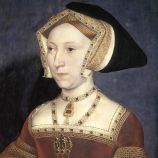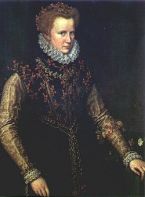 A speck on the palaces' walnut-paneled walls until 1536, Jane had spent a lifetime observing and absorbing what to do and, more to the point, how not to behave around the king. She was clever enough to remain chaste in a court renowned for its flirtatious, if not outright licentious, behavior. Although Jane was likely coached on how to massage the king-sized ego once his infatuation with her had begun, she was more than likely smarter than the average dishrag, and she was not without a certain degree of ambition for herself. She simply kept it better concealed than her black-eyed predecessor. Jane told the king what he wanted to hear and appeared to be everything he now sought in a consort. And Henry believed what he wanted to. A speck on the palaces' walnut-paneled walls until 1536, Jane had spent a lifetime observing and absorbing what to do and, more to the point, how not to behave around the king. She was clever enough to remain chaste in a court renowned for its flirtatious, if not outright licentious, behavior. Although Jane was likely coached on how to massage the king-sized ego once his infatuation with her had begun, she was more than likely smarter than the average dishrag, and she was not without a certain degree of ambition for herself. She simply kept it better concealed than her black-eyed predecessor. Jane told the king what he wanted to hear and appeared to be everything he now sought in a consort. And Henry believed what he wanted to.
~ Leslie Carroll, Royal Affairs | A Oak panel from Hampton Court. Carved on the panel is Jane Seymour's coat of arms combined with Henry VIII's. The crown above the arms symbolizes Jane's status as Queen, and the roses beside the crown represent Jane's entrance into the Tudor family. |
A possible Paramour?
The was a story that she had been attached to the son (William) of Sir Robert and Lady Dormer, a country neighbor, but was thought of too modest a rank to marry him (he then married into the Sidney family); even if true, the tale brought with it no slur on Jane's maidenly honour. It was told more as a Cinderella story, where the unfairly slighted girl would go on to be raised triumphantly to far greater heights. Her survival as a lady-in-waiting to two at the Tudor court still with a spotless reputation may indeed be seen as a testament to both Jane Seymour's salient characteristics -- virtue and common good sense. A Bessie Blount or Madge Shelton might fool around, Anne Boleyn might listen or even to the seductive wooings of Lord Percy: but Jane Seymour was unquestionably virginal.
~Antonia Fraser
 As so often with life, irony would follow: William Dormer's child would later be involved in the lives of Jane's son and her stepdaughter. As so often with life, irony would follow: William Dormer's child would later be involved in the lives of Jane's son and her stepdaughter.
Jane Dormer (perhaps named in honor of the late Queen), born in 1538 to William Dormer, would be a child permitted to Edward VI's company. Edward was reportedly fond of Jane. Jane would later be a maid to Mary I, as well as one of her closest friends. |
|